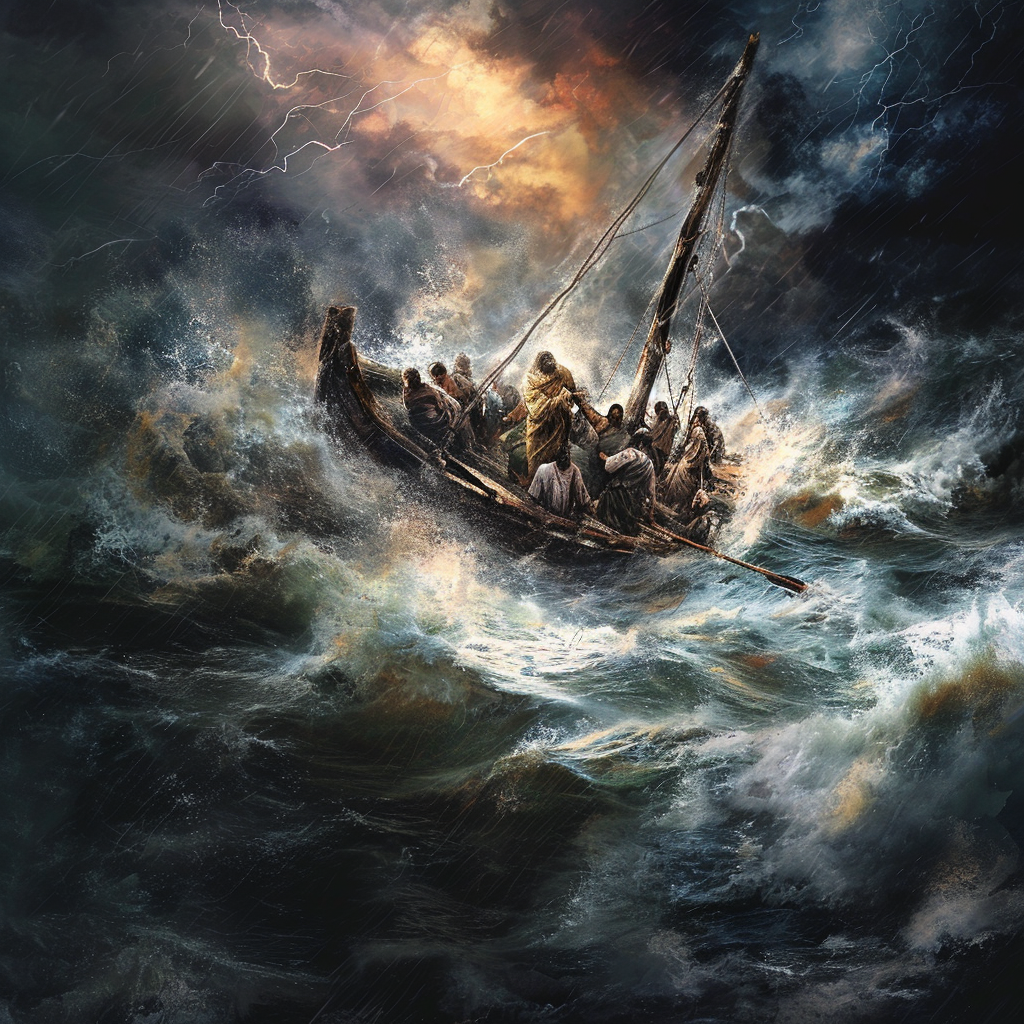Imagine the rushing turbulence of white water streaming over jagged boulders, tossing a raft unpredictably in different directions. The guide shouts instructions to paddle hard downstream as the crew tries to steer clear of impending rocks. How would one maintain composure and resilience amidst such intense forces beyond one’s control?
Jesus poses a similar question to his panic-stricken disciples aboard their battered boat on the stormy Sea of Galilee: “Why are you so afraid? Have you still no faith?” (Mark 4:35-41). When waves threaten to capsize their vessel, Jesus awakens to calm the wind and waters, then gently asks the meaningful question – why so afraid?

Created by DALL-E 3
Remaining Steady
This new year will likely have its share of personal and global tumult. How do we stay steady in the storm? We can turn to the spiritual tenacity embodied in Ignatian spirituality. Ignatius himself, after a cannonball wound derailed his military career, channeled his restless energy into an audacious quest to discern and accomplish God’s will for his life. His creativity in responding to difficulty with spiritual discipline forged a unique Ignatian brand of resilience.
This resilience is not white-knuckling nor denying the challenges of reality. Ignatian resilience takes a more contemplative approach centred on Ignatius’ idea of indifference: the trust that in God, all shall be well, whether in sickness or health, poverty or plenty. By releasing our tight grasp on specific outcomes, we gain freedom amidst the storm. We turn our focus inward to connect with the deep, abiding peace and steadfastness that comes from God’s presence. Contemplation allows one to remain resilient amidst the unpredictable rapids of life by fixing one’s gaze on the ultimate Navigator who transcends all suffering, singing that profound lyric from the hymn How Can I Keep From Singing: “No storm can shake my inmost calm.” I’ve always loved the peaceful, resilient spirit captured by those words.

Created by Midjourney
Practices of Resilience
At the core of this Ignatian resilience is the Examen, which involves pausing frequently to evaluate the currents and movements of our inner emotional landscape. Like expert rafters reading rapids before forging ahead, we train ourselves to attend to areas of consolation and desolation – where is spiritual fruit blossoming? What obstacles threaten to capsize me if not navigated well? By developing this self-awareness to name our interior weather, we position ourselves to invoke resilience when the next storm inevitably arises.
Through imaginative prayer I can envision Jesus beckoning me into the boat on the Sea of Galilee. Waves crashes violently as I cling to the sides for dear life. But amidst the chaotic spray, I behold profound peace radiating in Jesus’ eyes. Though the storm persists externally, he remains unshaken. This inmost calm settles my fears and stills my doubts. I can endure external chaos through internal grounding in God’s Spirit.
When facing life’s uncertainty, Ignatian resilience provides stabilising oars. By suspending frenzied attempts to control circumstances beyond our control, this spiritual approach invites us to patiently weigh alternatives as new data emerges. We evaluate options based on which brings enduring interior peace. Instead of relying on faulty human reasoning alone to predict unpredictable rapids, we access interior wisdom to gain freedom and courage to proceed ahead into the unknown future.
As we continue into the new year, may we be grounded in the hope of a God who calms the storms – and in that Ignatian resilience that sings, “No storm can shake my inmost calm.”
Related posts:
Listen to the podcast version of this post…
Written with the help of Claude and GPT-4.









A wonderful article arriving on a day when it is most needed–perfect timing. As I sit here wondering if my cancer is spreading, if my broken neck is healing, if I will return to the Catholic Church or not after 54 years, I smile with the workings of the Holy Spirit in bringing me this to contemplate. Thank you.